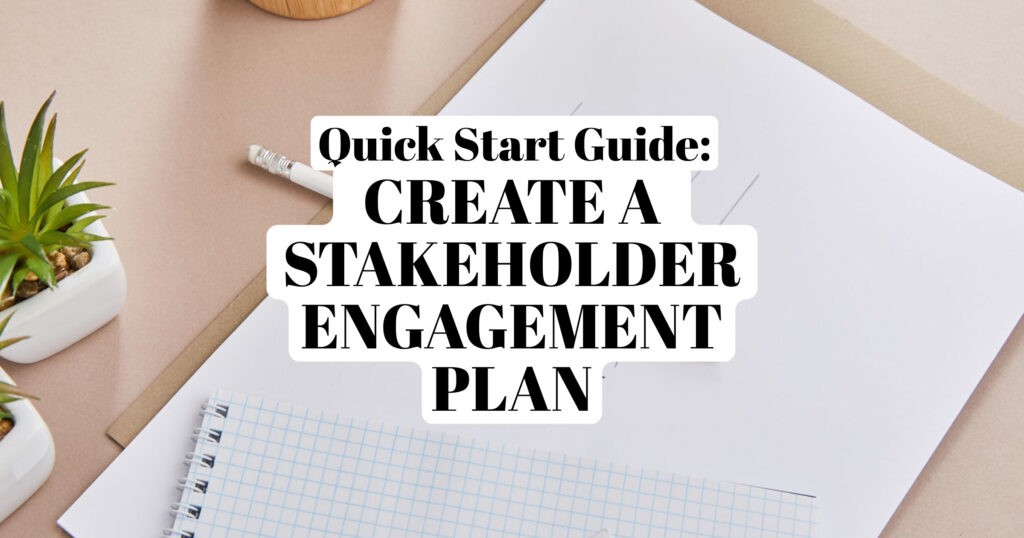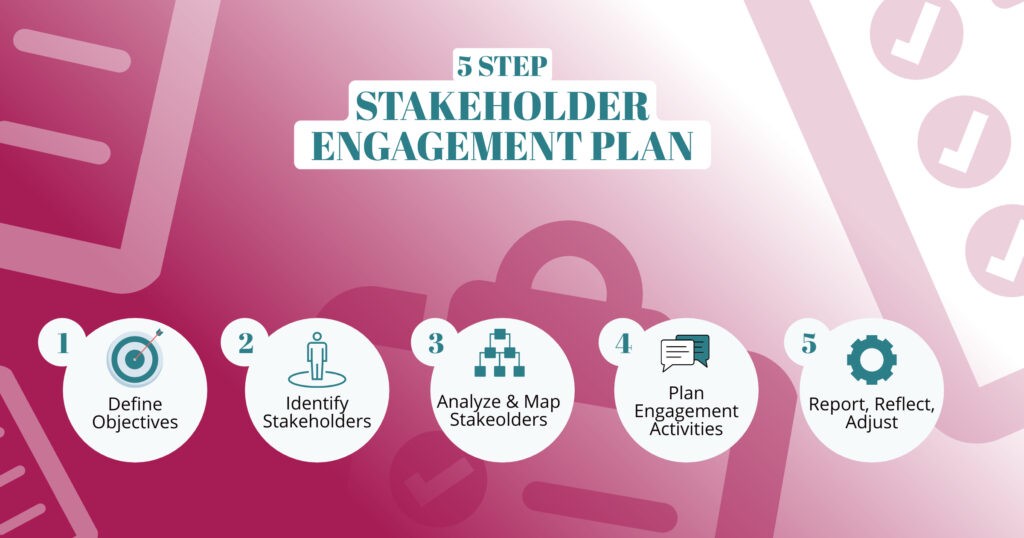Stakeholder Engagement Plans: Quick Start Guide

Need to create a stakeholder engagement plan quickly? We’ve put together this quick-start guide to cover all the high-level basics you need to know, or jump ahead to our simple, five-step process.
Stakeholder Engagement Planning Basics
Here are a few concepts you should be familiar with before you start your stakeholder engagement plan.
What is a Stakeholder Engagement Plan?
A stakeholder engagement plan is a document that outlines the key facts to guide your engagement strategy and process, such as:
- What you want to achieve
- Who you hope to engage with (and their characteristics)
- What engagement activities you’re undertaking
- How you’ll report on the engagement
You might hear other phrases used, such as a stakeholder management plan or community engagement plan. In practice these look and function very similar to a stakeholder engagement plan, but may have slightly different objectives.
The good news is that stakeholder plans don’t need to be lengthy documents that take months to prepare and approve — you can cover all the basics in a page or two (and your team will thank you for keeping it short!).
Tip: For the shortest possible path to creating your plan, fill out our stakeholder planning tool — it’ll help you generate a plan in minutes!
Why Write a Plan Before Engaging Stakeholders?

Stakeholder engagement without a plan is unlikely to be as successful (and it certainly won’t be following principles or best practice). That’s because…
- A plan will give you a clear direction to follow so that you can assign the appropriate resources and capacity to engage with stakeholders
- It’ll help you get on the same page as your team
- It will guide you through the most logical process, from start to finish
- You’ll be more effective, efficient, and use your time well
- You’ll know exactly what to do with stakeholder feedback and issues when they come through (which can be important for compliance)
- You’ll always begin with a purpose that’s strategically aligned with your project or organization
Best of all, when you successfully engage with stakeholders, you will tap into valuable information and resources, make better decisions, anticipate issues, reduce your risks, and be more likely to succeed with your project.
When to Create a Stakeholder Engagement Plan
Is now the right time to create your plan, or should you wait?
Most businesses can benefit from creating a plan to engage with stakeholders before they begin a project or stakeholder engagement campaign — the sooner, the better. But the bigger the project, the higher the stakes are, and the more critical it will be to get a robust engagement plan in place.
Of course, the question also implies that there could be a wrong time to create your stakeholder engagement plan.
Is it too early? It might be, if you’re not yet clear on the project, objectives, and stakeholders you need to engage — any plan created at this stage is unlikely to be useful.
Is it too late? If the project and opportunities to engage are close to an end, it might be too late to bother with a stakeholder engagement plan (this time around).
Will it be used? Finally, there’s also no point to creating a stakeholder engagement plan if you or your team is unlikely to use it. Instead, spend some time learning about (and educating others) on the benefits of a stakeholder engagement plan and how to use it.
A Simple Stakeholder Engagement Plan in 5 Steps

Open a blank document and follow our 5-step process to draft your own stakeholder engagement plan.
1. Define Objectives
Start your plan by writing down what you hope to achieve by engaging with stakeholders — these will help you report on your progress, stay on track with goals, and drive improvement. Example stakeholder engagement objectives include:
- Reach more stakeholders through your engagement
- Improve the wellbeing of the community
- Meet regulatory, corporate, or internal requirements
- Be more accountable or transparent
- Ensure greater sustainability
- Work more efficiently
- Increase support for a project or outcome
- Ensure human rights are supported
- Make better decisions based on more complete information
Of course, it’s ideal if you can write these as SMART goals and get as specific as possible with your objectives. For example, instead of just ‘reach more stakeholders’, you might aim to reach 50 different stakeholder groups in total, or three totally new stakeholder groups you’ve never reached before.
2. Identify Stakeholders
Keeping your objectives in mind, it’s time to record your stakeholder list — that is, all the stakeholders that may be impacted by, have an influence on, or an interest in the project. You might end up with quite a long list of individuals, groups, and organizations.
Then you’ll need to hone in on your key stakeholders that you must engage with to achieve your outcomes, and can realistically do so with the time and resources you have. If you’re not yet sure who your key stakeholders are, don’t worry too much, as this will become clearer in step 3.
3. Analyze & Map Stakeholders
| Stakeholder | Demographic info | Impact (high/low) | Influence (high/low) | Interests |
Now it’s time to get to know your stakeholders a little better. Start with some general stakeholder analysis and note down the characteristics you know about each stakeholder or group, such as their level of impact/influence, their interests, demographics, location, relationships, engagement preferences, and more. This data can allow you to:
- Conduct stakeholder mapping
- Organize your stakeholder lists and make them more manageable
- Group stakeholders together for efficient, relevant communication
- Determine which stakeholders you need to focus on (and when)
You could start by noting these details in a table or spreadsheet, similar to above. But ideally, you’ll have a stakeholder tool or software where you can easily record this information and produce visualizations that you can include in your plan.
4. Plan Engagement Activities & Communication
| Activity
Groups targeted, information disclosed, engagement format |
Responsible Team Member | Timing |
With all the foundations in place for your stakeholder engagement, it’s time to plan the activities and communication that will engage each key stakeholder group, in line with your objectives. Note down who you plan to target, what information you will disclose, and in what format you’ll reach them, along with the team member responsible for the task and when it will take place. In your plan, this might look a little like the table template above.
Some tips for planning your engagement activities include:
- Consider using a mix of traditional engagement methods and digital communication methods
- Tailor your message and format to different stakeholders so it’s relevant and accessible
- Consider a more hands-on or individualized approach, as well as greater frequency of activities and communications for key stakeholders
- Provide opportunities for stakeholders to respond with feedback, comments, and questions
- Make sure you listen to to your stakeholders, respond to issues, and engage in conversation where appropriate
Check out more stakeholder engagement tips and our ideas for keeping stakeholders engaged.
5. Report, Reflect, Adjust
Finally, your stakeholder engagement plan should include a short section to outline how you plan to track, evaluate, and report on your engagement — and who you need to report to.
For instance, every quarter, you may generate a stakeholder engagement report that shows what activities were undertaken, what stakeholders were reached, and any other outcomes. This could be used for internal reporting, and/or to show stakeholders how their feedback is being used. For instance, a collection of survey responses or comments may be linked to a specific decision, action, or change to the project.
Not only that, but you should regularly evaluate your engagement, adjust your plan, and keep your stakeholder lists up to date — with the goal of ongoing learning and improvement.
Simplify with Stakeholder Engagement Software
All you really need to get started with engaging stakeholders is this super simple plan. But it’s much easier to implement a stakeholder engagement plan when you have the right software to support the process, right from the start.
Simply Stakeholders has you sorted with features like stakeholder lists, record keeping, analysis, mapping, communications integrations, reporting, issues/sentiment tracking, tasks, automations, and much more.
Learn more in our blog on stakeholder software or reach out to our team to organize a demo of Simply Stakeholders.






























